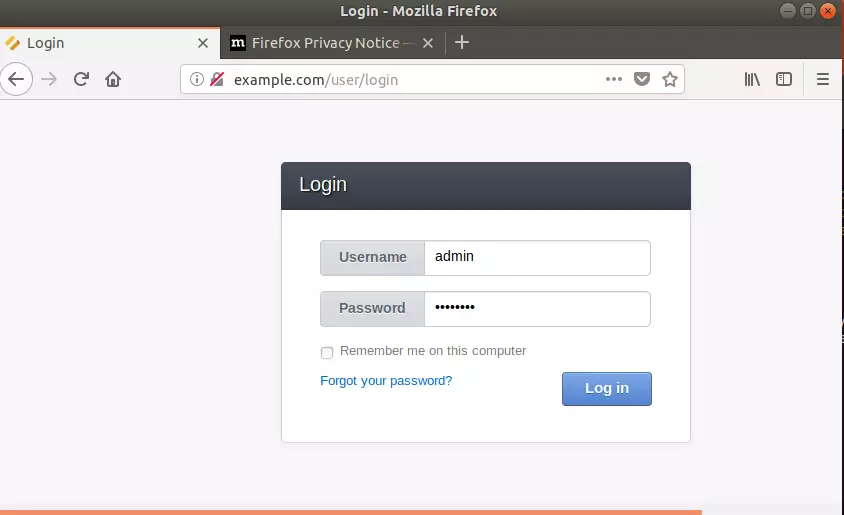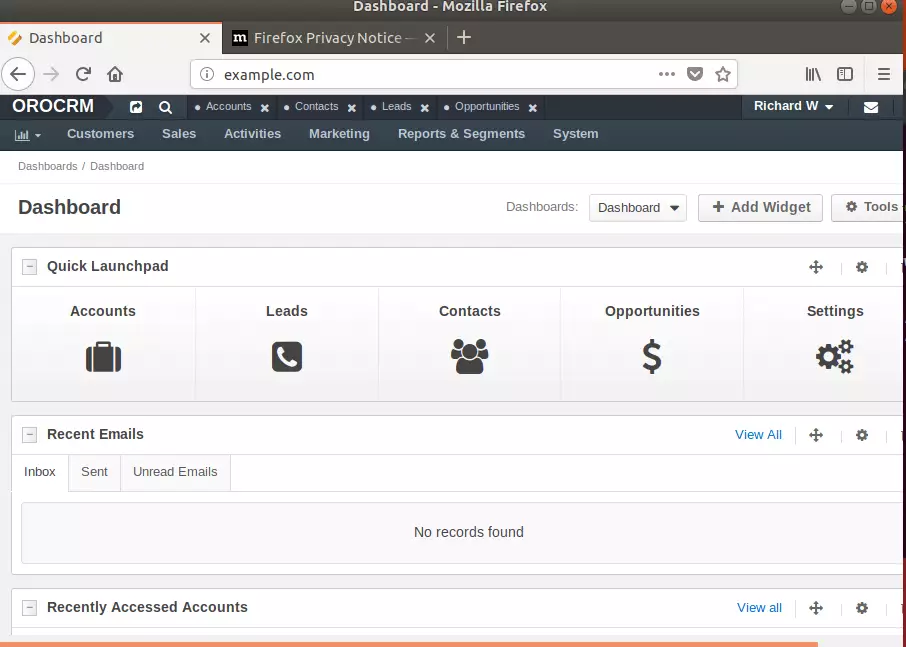This article explains setting up OroCRM with Nginx support on Ubuntu Linux.
OroCRM is an excellent place to start when looking for a customer relationship management solution for your business. This open-source CRM software is written in PHP and offers features that help you run your business and collaborate with your customers.
Setting up OroCRM with Nginx on Ubuntu Linux is an excellent choice because Nginx is a lightweight, high-performance web server that can handle a lot of traffic and requests. It is also known for its stability, reliability, and security.
Ubuntu Linux is a popular, easy-to-use operating system with much community support. OroCRM is an open-source CRM platform written in PHP and can help businesses manage their customer relationships more effectively.
Combining OroCRM with Nginx on Ubuntu Linux provides a robust and reliable solution for businesses of all sizes.
To get started with installing OroCRM, follow the steps below:
Install Nginx HTTP Server on Ubuntu
Nginx HTTP Server is the second most popular web server, so install it since OroCRM needs it.
To install Nginx HTTP on the Ubuntu server, run the commands below.
sudo apt update sudo apt install nginx
After installing Nginx, the commands below can be used to stop, start, and enable the Nginx service to always start up with the server boots.
sudo systemctl stop nginx.service sudo systemctl start nginx.service sudo systemctl enable nginx.service
To test the Nginx setup, open your browser and browse to the server hostname or IP address. You should see the Nginx default test page below. When you see that, then Nginx is working as expected.
http://localhost

Install MariaDB Database Server
MariaDB database server is a great place to start when looking at open-source database servers for Magento. To install MariaDB, run the commands below.
sudo apt-get install mariadb-server mariadb-client
After installing MariaDB, the commands below can stop, start, and enable the service to start when the server boots.
Run these on Ubuntu 16.04 LTS
sudo systemctl stop mysql.service sudo systemctl start mysql.service sudo systemctl enable mysql.service
Run these on Ubuntu 17.10 and 18.04 LTS
sudo systemctl stop mariadb.service sudo systemctl start mariadb.service sudo systemctl enable mariadb.service
After that, run the commands below to secure the MariaDB server by creating a root password and disallowing remote root access.
sudo mysql_secure_installation
When prompted, answer the questions below by following the guide.
- Enter current password for root (enter for none): Press the Enter
- Set root password? [Y/n]: Y
- New password: Enter the password
- Re-enter new password: Repeat password
- Remove anonymous users? [Y/n]: Y
- Disallow root login remotely? [Y/n]: Y
- Remove test database and access to it? [Y/n]: Y
- Reload privilege tables now? [Y/n]: Y
Restart MariaDB server
Type the commands below to log on to the MariaDB server to test if MariaDB is installed.
sudo mysql -u root -p
Then, type the password you created above to sign on. If successful, you should see a MariaDB welcome message.

Install PHP 7.1-FPM and Related Modules
PHP 7.2 isn’t available on Ubuntu’s default repositories. To install it, you will have to get it from third-party repositories.
Run the commands below to add the below third party repository to upgrade to PHP 7.1-FPM
sudo apt-get install software-properties-common sudo add-apt-repository ppa:ondrej/php
Then update and upgrade to PHP 7.1-FPM
sudo apt update
Next, run the commands below to install PHP 7.2 and related modules.
sudo apt install php7.1-fpm php7.1-common php7.1-curl php7.1-intl php7.1-mbstring php7.1-mcrypt php7.1-json php7.1-xmlrpc php7.1-soap php7.1-mysql php7.1-gd php7.1-xml php7.1-cli php7.1-zip
After installing PHP 7.2, run the commands below to open Nginx’s PHP default config file.
sudo nano /etc/php/7.1/fpm/php.ini
Then, save the changes on the following lines below in the file. The value below is an ideal setting to apply in your environment.
file_uploads = On allow_url_fopen = On memory_limit = 512M upload_max_filesize = 100M cgi.fix_pathinfo = 0 max_execution_time = 360 date.timezone = America/Chicago
After making the change above, please save the file and close it.
After installing PHP and related modules, you must restart Nginx to reload PHP configurations.
To restart Nginx, run the commands below
sudo systemctl restart nginx.service
Create OroCRM Database
Now that you’ve installed all the required packages continue below to start configuring the servers. First, run the commands below to create the OroCRM database.
Run the commands below to log on to the database server. When prompted for a password, type the root password you created above.
sudo mysql -u root -p
Then, create a database called orocrm
CREATE DATABASE orocrm;
Create a database user called orocrmuser with a new password
CREATE USER 'orocrmuser'@'localhost' IDENTIFIED BY 'new_password_here';
Then, grant the user full access to the database.
GRANT ALL ON orocrm.* TO 'orocrmuser'@'localhost' IDENTIFIED BY 'user_password_here' WITH GRANT OPTION;
Finally, save your changes and exit.
FLUSH PRIVILEGES; EXIT;
Install Node.js and Composer
OroCRM requires Node.js and Composer to be installed on the system. You’ll need these tools to download and install OroCRM. To install these packages, run the commands below.
curl -sS https://getcomposer.org/installer | sudo php -- --install-dir=/usr/local/bin --filename=composer
The commands above will download Composer from its maintainer page and install it into the /usr/local/bin directory. This is a local-global directory for application executables.
If you don’t have curl installed, run the commands below to install it with git. Then, rerun the commands above.
sudo apt install curl git
Next, run the commands below to install Node.js
sudo curl --silent --location https://deb.nodesource.com/setup_8.x | sudo bash - sudo apt install nodejs
Download OroCRM Latest Release
Next, visit the OroCRM site and download the latest version.
After downloading, run the commands below to extract the download file into the Nginx root directory.
cd /var/www/html/ sudo git clone -b 2.4 https://github.com/oroinc/crm-application.git orocrm cd orocrm sudo composer install --prefer-dist --no-dev
When you run the commands above, you’ll be asked for the database connection info you created above.
Some parameters are missing. Please provide them. database_driver (pdo_mysql): database_host (127.0.0.1): database_port (null): database_name (oro_crm): orocrm database_user (root): orocrmuser database_password (null): user_password_here mailer_transport (smtp): mailer_host (127.0.0.1):
Next, run the commands below to complete the installation
sudo php app/console oro:install --env=prod
You’ll be prompted to create an admin account to manage the backend during the setup.
Administration setup. Application URL (http://localhost): Organization name (OroCRM): Username (admin): Email: [email protected] First name: Richard Last name: W Password: Load sample data (y/n): y
Then, run the commands below to set the correct permissions for OroCRM to function.
sudo chown -R www-data:www-data /var/www/html/orocrm/ sudo chmod -R 755 /var/www/html/orocrm/
Configure Nginx
Finally, configure the Apahce2 site configuration file for OroCRM. This file will control how users access OroCRM content. Run the commands below to create a new configuration file called orocrm
sudo nano /etc/nginx/sites-available/orocrm
Then copy and paste the content below into the file and save it. Replace the highlighted line with your domain name and directory root location.
server {
listen 80;
listen [::]:80;
root /var/www/html/orocrm/web;
index index.php index.html index.htm;
server_name example.com www.example.com;
client_max_body_size 100M;
location / {
try_files $uri /app.php$is_args$args;
}
location ~ ^/(app|app_dev|config|install)\.php(/|$) {
include snippets/fastcgi-php.conf;
fastcgi_pass unix:/var/run/php/php7.1-fpm.sock;
fastcgi_param SCRIPT_FILENAME $document_root$fastcgi_script_name;
}
}
Save the file and exit.
Enable the OroCRM
After configuring the VirtualHost above, please enable it by running the commands below.
sudo ln -s /etc/nginx/sites-available/orocrm /etc/nginx/sites-enabled/
Restart Nginx by running the commands below to load all the settings above.
sudo systemctl restart nginx.service
Then open your browser and browse to the server domain name, followed by install. Finally, you should see the ORO CRM setup wizard complete. Please follow the wizard carefully.
http://example.com
Then, type the admin username and password you created above to sign in.

Enjoy!

You may also like the post below:

Leave a Reply